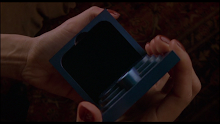It’s 1955. We take a starry night out of the black box/a starry night comes out of the blackbox. It’s a night for a hunter...

A sweet old lady’s face appears slowly amidst a field of stars...
talking to star-like little children.
Lilan Gish as Rachel Cooper tells us a story from the starry sky.Her point of view is also the children’s and the spectators’, who are discovering the story.
A realistic depth is not necessary for this field of stars. Two dimensions are enough for this story to take place.

This two dimensional space is the place of confrontation between Good and Evil.
It is a symbolic place. The canvas representing a starry sky is the simplistic and naïf décor of the story.





As we get closer, we see a group of children playing hide and go seek. Almost simultaneously, we discover Evil and Misfortune on Earth.



The spectators leave the crime scene behind
and follow a man driving his car down a road.
The editing suggests a link between the previous scene and this preacher/sinner.
The field of stars, shining dots on a black background is, in all its cinematographic simplicity, a metaphorical space. The metaphor of Good, embodied by the old lady; of God whom the Machiavellian, mundane preacher speaks to, raising his eyes to the sky.
The setting is a haunted night, haunted by the hunter.
The moonlight on the barn is unreal. Realism is not necessary for the spectator to believe this story.
The sky becomes a shadow theatre, as we discover the monstrous shadow of the hunter, the ogre who “never sleeps”.
At the end of the movie, a Christmas garland decorated with golden stars in the background reminds us of the simple starry night décor of the beginning.
Maybe this starry night, this night of the hunter, is a poetic space where our deepest childhood fears are projected.
















navigate to this web-site replica designer bags pop over here visit additional resources click this site
RépondreSupprimergucci replica handbags t64 g4t09c1x22 replica gucci j95 v8j68h7s30 replica bags online a31 f6c95q7h71
RépondreSupprimer